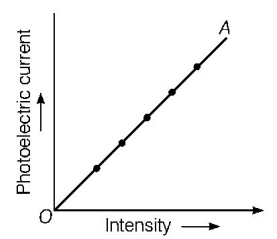Question
A photocell employs photoelectric effect to convert
A.
change in the frequency of light into a change in electric voltage
B.
change in the intensity of illumination into a change in photoelectric current
C.
change in the intensity of illumination into a change in the work function of the photocathode
D.
change in the frequency of light into a change in the electric current
Answer :
change in the intensity of illumination into a change in photoelectric current
Solution :
In a photoelectric effect, when monochromatic radiations of suitable frequency fall on the photosensitive plate called cathode, the photoelectrons are emitted which get accelerated towards anode. These electrons flow in the outer circuit resulting in the photoelectric current.

Using the incident radiations of a fixed frequency, it is found that the photoelectric current increases linearly with the intensity of incident light as shown in figure. Hence, a photocell employs photoelectric effect to convert change in the intensity of illumination into a change in photoelectric current.
In a photoelectric effect, when monochromatic radiations of suitable frequency fall on the photosensitive plate called cathode, the photoelectrons are emitted which get accelerated towards anode. These electrons flow in the outer circuit resulting in the photoelectric current.

Using the incident radiations of a fixed frequency, it is found that the photoelectric current increases linearly with the intensity of incident light as shown in figure. Hence, a photocell employs photoelectric effect to convert change in the intensity of illumination into a change in photoelectric current.